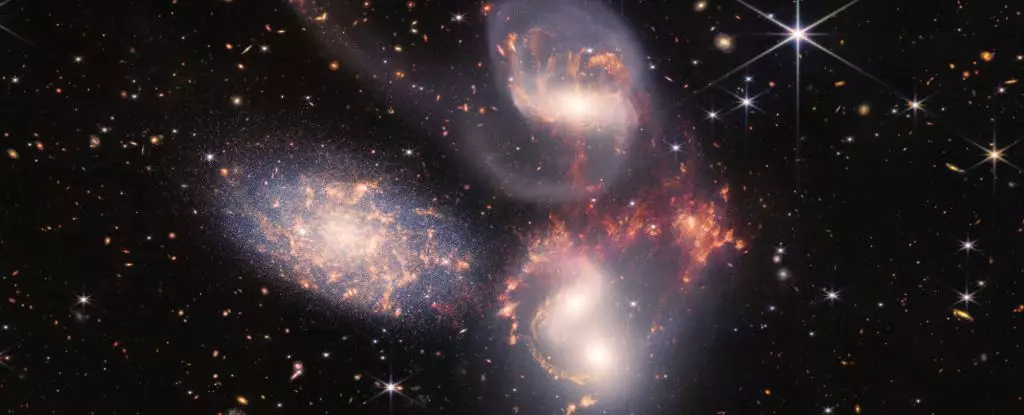In the vast expanse of the universe, approximately 290 million light-years from Earth, lies a profound astronomical phenomenon—the intricate interplay between a group of galaxies known as Stephan’s Quintet. Discovered in 1877, this quintet has dazzled astronomers with its dynamic nature, characterized by the remnants of past galaxy collisions strewn across the cosmic landscape. The captivating spectacle reveals a powerful X-ray shock front ignited by the dynamic interactions of these celestial bodies. Researchers have recently delved deeper into this galactic assembly, unearthing compelling insights into the chaos and beauty generated by their gravitational dances.
The Collision Course
At the heart of this galactic orchestra is the galaxy designated NGC 7318b, a celestial entity behaving like a cosmic wrecking ball as it barrels through the cluster at an astounding velocity of 3.2 million kilometers per hour (approximately 2 million miles per hour). This collision is of monumental significance, as it not only highlights the momentum one galaxy can impart on others within close proximity but also serves as a window into the processes that govern the birth and evolution of larger galaxies. Astrophysicists believe that such interactions are pivotal for understanding how gravitational forces collect matter over time, allowing galaxies to merge and evolve into sprawling behemoths.
Marina Arnaudova, an esteemed astrophysicist at the University of Hertfordshire, comments on the fascination inherent in Stephan’s Quintet. She notes that the complex field of debris left in the aftermath of previous galactic collisions serves as a historical record of cosmic events. The existence of such a dynamic region, particularly one so close to our own Milky Way, fuels scientific efforts to decode the intricate mechanisms underpinning galaxy formation and evolution.
Illuminating the Unexpected
Recent observations utilizing the William Herschel Telescope’s Enhanced Area Velocity Explorer (WEAVE) in Spain have unveiled unprecedented details within the shocked gas surrounding the colliding galaxies. These first-light results present a novel perspective on how the interaction alters the properties of the gases that act as intermediaries in the cosmic exchange. Notably, NGC 7318b’s impact generates a shock wave extending larger than the Milky Way itself, prompting a dual response from the gas it encounters.
The shock front exhibits two distinct characteristics: while interacting with colder gas, it moves rapidly, tearing electrons from atoms and illuminating the gas in a spectacular display of charged particles. Conversely, when interacting with hotter gas, the shock weakens, resulting in a compression effect that generates low-frequency emissions identifiable by radio telescopes, such as the Low-Frequency Array (LOFAR). This nuanced understanding reveals a cascading energy exchange that propagates through the various phases of gas within the intergalactic medium, offering a glimpse of the underlying processes driving these dramatic celestial events.
The LOFAR observations also provide vital temporal insights, indicating that the energized particles within the shocked gas have existed for approximately 11 million years, paralleling the crossing timeline of NGC 7318b. This aligns with the understanding that such energetic phenomena are not isolated incidents but part of an intricate timeline that unfolds across cosmic epochs. Understanding these timelines is critical as astrophysicists strive to decode the growth patterns of galaxies and their hijinks across the universe.
Throughout history, Stephan’s Quintet has remained a prime subject for scientists, as it presents a rare opportunity to study such intricate galactic interactions so close to home. The continuous collision and merger of galaxies like those in this quintet suggest that galactic evolution is far from a quiet affair. Instead, it is a frenetic dance of forces, characterized by chaos and creation, which adds layers of complexity to our understanding of the universe’s structure.
The evidence brought to light by WEAVE signifies a promising era of astrophysical research, emphasizing the importance of innovative instrumentation in unlocking the universe’s secrets. Gavin Dalton, an astrophysicist from the University of Oxford, expresses excitement over the advancements made through recent observations, highlighting the breadth of detail that can now be achieved. This underlines the potential for future discoveries as new technologies continue to emerge, allowing scientists to see beyond the limits of olf instrumentation and explore previously hidden cosmic phenomena.
The ceaseless interactions within Stephan’s Quintet present an ongoing narrative of collision and evolution amidst the vast cosmos. Each observation brings us one step closer to understanding the fundamental processes that shape galaxies across the universe, illuminating the cosmic tapestry of which we are an integral part. The story of these galaxies, told through the lenses of cutting-edge telescopes, serves as a reminder of the dynamic and ever-evolving universe that surrounds us, full of mysteries yet to be uncovered.


Leave a Reply